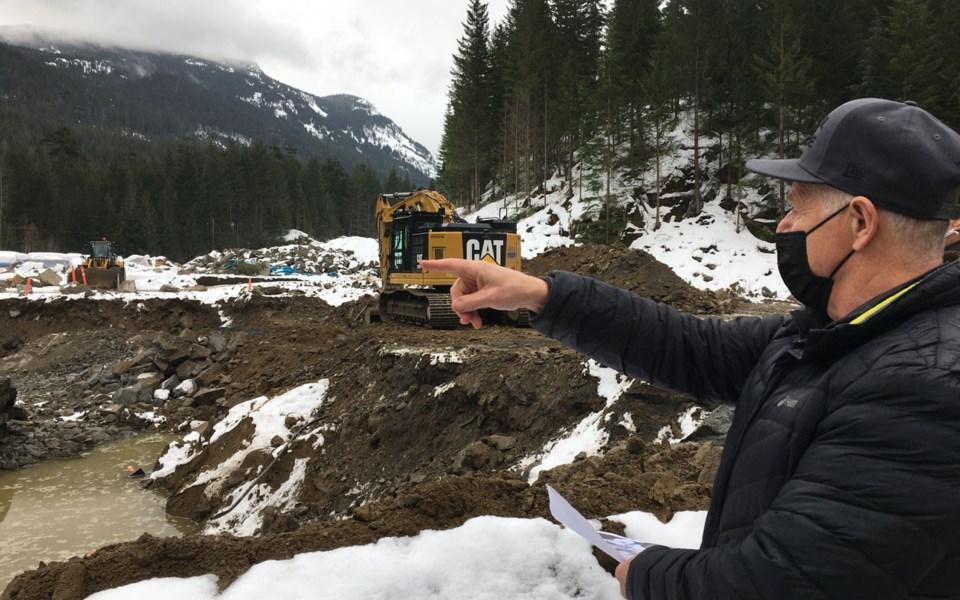Construction is set to begin on the second phase of Cheakamus Crossing after Whistler council adopted a rezoning bylaw for the land on March 16.
The bylaw comes with a series of conditions that must be met, on which Resort Municipality of Whistler (RMOW) staff has worked with applicant the Whistler 2020 Development Corp. (WDC), said planner John Chapman in a presentation to council.
The conditions include: dedication and detailed design of a new park for the neighbourhood; an extension of Mount Fee Road, along with two new bus shelters; registration of environmental protection covenants (restricting development within 30 metres of the Cheakamus River, or within any streamside or wetland areas); securing access to recreation trails in the area; and securing progressive green building commitments for all new developments on the land.
“Staff have worked with the [WDC] to craft agreements to satisfy the zoning adoption conditions,” Chapman said.
“WDC has confirmed [its] consent to these agreements, and this will enable adoption of the bylaw.”
As the Riverside Trail crosses three parcels, “a statutory right-of-way will be established in those locations to ensure ongoing public access and access for maintenance as necessary,” Chapman said, adding that the Ridge Trail, which crosses Parcel E, will get similar treatment.
That said, development of Parcel E is still several years off.
“There is a covenant on this land restricting development until further planning is done, which will include a further environmental review to identify significant natural features, identify any sensitive ecosystem areas, and ensure that a statutory right-of-way will be established for the Ridge Trail, which crosses this parcel,” Chapman said.
As it relates to green building requirements, Chapman noted there is an existing covenant on the lands requiring a connection to the District Energy System (DES) for interior space and domestic hot water heating.
“We crafted a [new] covenant that provides options moving into the future to maximize building energy and efficiency performance, and balance the costs as well,” he said.
Multi-family buildings in Cheakamus Phase 2 will utilize the DES for hot water heating, but will have the option to opt for alternative energy sources so long as they build to a higher energy standard than is required in the building bylaw, Chapman said.
“For the smaller Part 9 or single-family and duplex buildings, we expect that they will elect to forego connection to the DES due to inefficiencies, and in exchange they would again be required to build to that higher energy performance standard,” he said.
“This is a flexible, adaptable scheme to ensure that we’re getting the best performing buildings through this multi-phase, multi-year build out.”
In response to a question from Councillor John Grills about the total capacity of the DES, general manager of infrastructure James Hallisey noted a recent study showed the system has enough capacity for Phase 2, excluding Parcel D2, which is at a higher elevation.
“There is some assumptions about those buildings being built to a higher energy standard than what’s been built in the past, but there is also the ability to expand our heat recovery out of the wastewater, to some extent,” Hallisey said.
“There is piping and a space allocated at the wastewater treatment plant for another heat exchanger to extract more heat from the wastewater if we need to do that.”
Despite the project’s compressed timeline to date, “I think everyone’s arrived at a good solution,” said Coun. Duane Jackson.
“I think we’ve got more work to do, particularly on the energy side, and I think that James [Hallisey] and his engineering team are working on the cost/benefit analysis, and understanding sort of best practices going forward,” Jackson said.
“And certainly WDC is investing in that knowledge so that they can inform council on future projects, how best we can meet our energy needs and still maintain affordable housing.”
For Mayor Jack Crompton, walking around the site and seeing it start to come together—and considering the contributions of all the Whistlerites to date—is a proud moment.
“This, for me, is a very proud vote that we will cast here,” Crompton said.
“It moves us in a very positive direction, and I’m grateful to everyone that’s had a part.”




